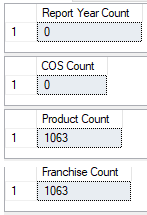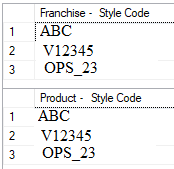I have the following "Handshake" table:
CREATE TABLE [dbo].[Handshake](
[Report Year] [varchar](100) NULL,
[Status] [varchar](100) NULL,
[Update Time] [datetime] NULL,
[Process Time] [datetime] NULL
) ON [PRIMARY]
GO
Some data here:
Report Year Status Update Time Process Time
2020 1+2 Loaded 2020-08-25 13:10:19.073 NULL
2020 6+8 Loaded 2020-08-25 13:11:30.733 NULL
2020 1+2 Loaded 2020-08-25 13:11:47.257 NULL
I have another table, "Fact", that is used to insert the load of these above "Report Years" every time and and a record is inserted into the Handshake table when the back-end process starts to load/updates status from "WIP" to "Loaded" upon load completion, as you can see from the sample Handshake data above.
After the status is "Loaded", I go in manually every time and run the following queries against "Fact" Table to validate the data against other tables.
SELECT COUNT(*) as 'Report Year Count' FROM Fact WHERE [Report Year] NOT IN ( SELECT DISTINCT [Report Year] FROM [Report Year] )
SELECT COUNT(*) as 'COS Count' FROM Fact WHERE [Country Code] NOT IN ( SELECT DISTINCT [Country Code] FROM [COS] )
SELECT COUNT(*) as 'Franchise Count' FROM Fact WHERE [Style Code] NOT IN ( SELECT DISTINCT [Style Code] FROM [Franchise] )
SELECT COUNT(*) as 'Product Count' FROM Fact WHERE [Style Code] NOT IN ( SELECT DISTINCT [Style Code] FROM [Product] )
If the count is 0 for the above queries, then i dont check what the rejects are for those tables.
if the count is > 0, i run a similar query to identify the rejects.
For example, if Franchise and Product return a count of 1063

Then I run the following relevant query(s) to identify the missing rejects in those tables:
SELECT DISTINCT [Style Code] as 'Franchise - Style Code' FROM Fact WHERE [Style Code] NOT IN ( SELECT DISTINCT [Style Code] FROM [Franchise] )
SELECT DISTINCT [Style Code] as 'Product - Style Code' FROM Fact WHERE [Style Code] NOT IN ( SELECT DISTINCT [Style Code] FROM [Product] )

If there are "rejects" (inconsistent data), i send an email to relevant users with what the rejects where so that they can update the tables (i.e. Franchise, COS, Product, Report Year) to include the missing rejects before i proceed with the next step (processing the database).
Instead of continuously performing this validation task manually, I'd like to write a stored procedure that will be triggered by some form of script/job (irrelevant to the scope of this thread for now) that will check the Handshake table for the latest "Loaded" status, run the validation queries, and if there are rejects, update the status for that record in the Handshake table from "Loaded" -> "Rejects". Otherwise, if there are no rejects, update the status to "Good" for no rejects found.
If there are rejects, i'd like to save the results to a scalar variable (i.e. cmd) so that i can extract them later into a csv file of sorts
This is my pseudocode:
CheckForRejects()
DECLARE @cmd NVARCHAR(1000)
BEGIN
--check Handshake Status.
IF Status='Loaded' THEN --RUN Validation Queries
SELECT COUNT(*) as 'Report Year Count' FROM Fact WHERE [Report Year] NOT IN ( SELECT DISTINCT [Report Year] FROM [Report Year] )
SELECT COUNT(*) as 'COS Count' FROM Fact WHERE [Country Code] NOT IN ( SELECT DISTINCT [Country Code] FROM [COS] )
SELECT COUNT(*) as 'Franchise Count' FROM Fact WHERE [Style Code] NOT IN ( SELECT DISTINCT [Style Code] FROM [Franchise] )
SELECT COUNT(*) as 'Product Count' FROM Fact WHERE [Style Code] NOT IN ( SELECT DISTINCT [Style Code] FROM [Product] )
case
when 'Report Year Count' > 0 THEN
SET Status='Rejects'
SET @cmd = SELECT DISTINCT [Report Year] as 'Report Year' FROM Fact WHERE [Report Year] NOT IN ( SELECT DISTINCT [Report Year] FROM [Report Year] )
when 'COS Count' > 0 THEN
SET Status='Rejects'
SET @cmd = SELECT DISTINCT [Country Code] as 'COS - Country Code' FROM Fact WHERE [Country Code] NOT IN ( SELECT DISTINCT [Country Code] FROM [COS] )
when 'Franchise Count' > 0 THEN
SET Status='Rejects'
SET @cmd = SELECT DISTINCT [Style Code] as 'Franchise - Style Code' FROM Fact WHERE [Style Code] NOT IN ( SELECT DISTINCT [Style Code] FROM [Franchise] )
when 'Product Count' > 0 THEN
SET Status='Rejects'
SET @cmd = SELECT DISTINCT [Style Code] as 'Product - Style Code' FROM Fact WHERE [Style Code] NOT IN ( SELECT DISTINCT [Style Code] FROM [Product] )
ELSE SET Status='Good' -- No Rejects, continue to processing DB
END
SELECT @cmd As Rejects


